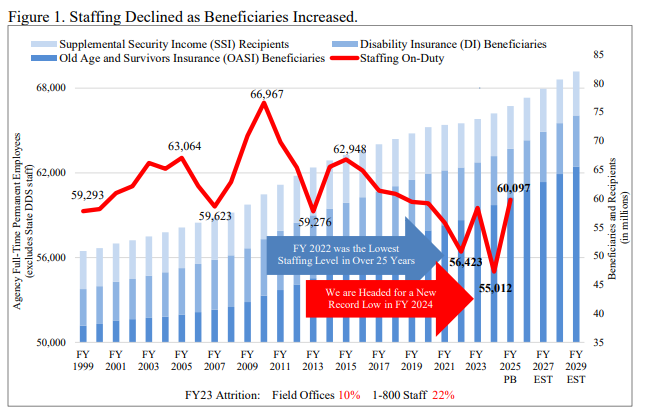O’Malley outlines plans to rebuild Social Security Administration workforce
After a hiring freeze, Commissioner Martin O’Malley is readying plans to rebuild the Social Security Administration workforce as quickly as possible.
After a months-long hiring freeze, the Social Security Administration is once again facing even further declining staffing numbers.
But with agency spending now determined for the rest of fiscal 2024, and hiring now unfrozen, SSA Commissioner Martin O’Malley is readying the agency’s plans to rebuild its workforce as quickly and efficiently as possible.
Currently, SSA is at its lowest staffing levels in 27 years, while serving more customers than ever before, O’Malley told lawmakers on the House Ways and Means Committee during a hearing last week. As a result, customer service has worsened — there are longer wait times on phone lines, and longer delays in receiving decisions on disability applications and appeals.
The perfect storm of challenges, largely due to years of continuing resolutions and hiring freezes, is leading to overworked employees who often leave their jobs within just a year or two, O’Malley said during the joint hearing of the Social Security and Work and Welfare subcommittees.
“We need to do better by them,” O’Malley said. “They’re overwhelmed, stressed out — but still, every day, they’re trying to make it work.”
In the 2024 spending agreement Congress reached last week, SSA received $14.2 billion for its administrative expenses. It’s a slight increase over SSA’s enacted budget of $14.1 billion for 2023.
“It’s a lot better than a cut — and I know cuts were on the table,” O’Malley said.
Spending proposal for 2025
A couple years back, SSA was successful in boosting its staffing numbers — at least for a short time. But the agency quickly faced attrition, particularly in teleservice centers and state disability determination services (DDS), as a result of overworked, overwhelmed employees who didn’t receive enough training to do their jobs effectively.
Although SSA’s latest hiring freeze has ended, there have already been net staffing losses as a result of a months-long string of continuing resolutions — landing the agency once again at the lower staffing levels it had a year ago.
“Unfortunately, we expect that backlogs and wait times will grow in 2024 due to the hiring freeze and minimal overtime,” SSA said in its 2025 budget request justification document. “While we expect to process more cases this year, we will have significantly less staff at the end of the year than at the beginning.”

O’Malley called the declining staffing numbers a “severe setback.”
Right now, SSA employees “are understaffed, and they are overwhelmed,” O’Malley said. “Not surprisingly, when somebody’s been on hold for an hour, they come off that call hot. We right now have an attrition rate of about 24% in our teleservice centers.”
Much more is necessary for the agency to improve staffing, and by extension customer service, for years to come, O’Malley said. The Biden administration is requesting $15.4 billion for the Social Security Administration’s 2025 budget.
The goal is to bring the agency back above the end-of-year staffing levels from 2023 — aiming to reach nearly 60,000 employees, and at the same time, begin to process more cases.
The request would invest in more SSA staffing across the board — with a proposed $269 million for field offices, $85 million for processing centers, $89 million for hearing centers, $79 million for teleservice centers and $2.8 billion for DDS.
More plans to rebuild staffing
To try to make the proposed investments worthwhile, O’Malley is outlining a specific, targeted hiring plan for the agency, aiming to improve not only hiring, but also retention of employees.
“We need to change our strategy as an agency,” O’Malley told lawmakers. “I think we target too much on college graduates and not enough on high school and community college graduates. And with proper training, that could really be an investment that holds for a long time.”
After the Senate confirmed O’Malley as commissioner in December, he spent his first few months on the job visiting Social Security Administration offices across the country to learn about the challenges staff face on the job and to look for possible solutions.
As the agency looks to rebuild, taking into consideration conversations with staff, O’Malley detailed plans for how the agency will hire for the long-term, aiming to avoid attrition and mitigate high turnover rates SSA has historically experienced.
Over the next year, SSA is planning to focus in part on veterans hiring, training and retention, while also partnering with universities and institutions that work with underserved communities. SSA is also requesting funding to hire 1,500 interns in 2025.
“We are increasing the use of social media platforms to recruit students, recent graduates and direct hire applicants and attract top talent from anywhere in the country,” SSA said.
Concerns remain in Congress
Still, some lawmakers, including subcommittee Chairman Drew Ferguson (R-Ga.), called on O’Malley to target improvements for the Social Security Administration in the immediate short-term.
“My free advice is to get the existing workload under control — get it back on track before we go dumping more cases into it,” Ferguson said during last week’s hearing.
A few other lawmakers also pointed to the importance of IT modernization as a way to ultimately improve workforce performance and morale.
“We improve people’s work experience by investing in these technologies to make their job satisfaction go up,” Rep. Blake Moore (R-Utah) said. “You get better productivity out of them, and we’ll see better hiring come from this type of stuff.”
Even so, O’Malley said, currently 90% of SSA’s IT budget goes toward simply maintaining outdated, legacy systems — and not toward actually modernizing SSA.
“Think, if you will, about the city of Jerusalem being built up over years, except this is cobalt and green screens,” O’Malley said during the hearing. “Only 10% of [the budget] goes to modernization.”
The budget request for 2025 includes $1.7 billion to invest in IT modernization. The funding will in part go toward efforts to expand online services and provide SSA employees with more user-friendly systems and tools to perform their work.
The Social Security Administration has the next 90 days to provide a report to congressional appropriations committee members with details on full-time employees, new hires in each agency component and retention rates of staff.
Copyright © 2025 Federal News Network. All rights reserved. This website is not intended for users located within the European Economic Area.
Drew Friedman is a workforce, pay and benefits reporter for Federal News Network.
Follow @dfriedmanWFED






